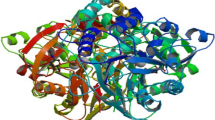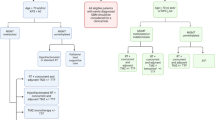Abstract
Purpose of Review
The pathophysiology of glioblastoma is so complex; it affects a number of different cellular processes. The FDA has approved a number of treatments, including temozolomide and bevacizumab, yet the survival rate remains the same at 1 year or less. As a result of the failure of different chemotherapies and target pharmacological therapies, we must concentrate on the use of less toxic agents, such as natural compounds, which may have a greater prognostic value.
Recent Findings
This quick overview covers the following topics: Glioblastoma has a variety of various routes associated with it, including molecular and patrimonial indications. Treatments for glioblastoma are available. Certain natural compounds may have the ability to minimize toxicity while also improving prognostic value.
Summary
Glioblastoma multiforme is a grade 4 glioma brain tumor that develops from glial cells in the brain. The grade of a brain tumor indicates how probable it is to grow and spread. Grade 4 tumors are the most dangerous and aggressive. Despite the FDA’s approval of temozolomide with bevacizumab and several other drugs, the 1-year survival rate remains constant. We must focus on the use of less toxic agents, such as natural compounds, that may have a greater prognostic value and less toxicity, due to the failure of various chemotherapies, surgeries, radiation, and target pharmaceutical therapies.



Similar content being viewed by others
Abbreviations
- ATRX:
-
Alpha-thalassemia\mental retardation syndrome X-linked
- CDK4:
-
Cyclin-dependent kinase 4
- CSF:
-
Cerebrospinal fluid
- EGFR:
-
Epidermal growth factor receptor
- FGFR:
-
Fibroblast growth factor receptor
- FAK:
-
Focal adhesion kinase
- GBM:
-
Glioblastoma
- HIF-1:
-
Hypoxia-inducible factor-1
- HGF:
-
Hepatocyte growth factor
- IGF-1R:
-
Insulin-like growth factor 1 receptor
- IHC:
-
Immunohistochemistry
- IDH:
-
Isocitrate dehydrogenase
- mTOR:
-
Mammalian target of rapamycin
- MAPK:
-
Mitogen-activated protein kinase
- MET:
-
Proto-oncogene mesenchymal epithelial transition
- MGMT:
-
06-Methylguanine-DNA methyltransferase
- PCR:
-
Polymerase chain reaction
- PDGFR:
-
Platelet-derived growth factor receptor
- PTEN:
-
Phosphatase and tensin homology
- PXN:
-
Paxilline
- TP53:
-
Tumor protein 53
- TMZ:
-
Temozolomide
References
Papers of particular interest, published recently, have been highlighted as: • Of importance •• Of major importance
Pearson J, Regad T. Targeting cellular pathways in glioblastoma multiforme. Signal Transduct Target Ther. 2017;2(1). https://doi.org/10.1038/sigtrans.2017.40 The mechanisms related with glioblastoma were systematically summarized in this review.
Davis ME. Glioblastoma: overview of diseases and treatment. Clin J Oncol Nurs. 2016;20(5 Suppl):S2–8. https://doi.org/10.1188/16.CJON.S1.2-8.
Korf BR. Neurofibromatosis. Handb Clin Neurol. 2013;111:333–40. https://doi.org/10.1016/B978-0-444-52891-9.00039-7.
Cimino PJ, Gutmann DH. Neurofibromatosis type 1. Handb Clin Neurol. 2018;148:799–811. https://doi.org/10.1016/B978-0-444-64076-5.00051-X.
Asthagiri AR, Parry DM, Butman JA, Kim HJ, Tsilou ET, Zhuang Z, Lonser RR. Neurofibromatosis type 2. Lancet (Lond, Engl). 2009;373(9679):1974–86. https://doi.org/10.1016/S0140-6736(09)60259-2.
Kratz CP, Achatz MI, Brugières L, Frebourg T, Garber JE, Greer MC, Hansford JR, Janeway KA, Kohlmann WK, McGee R, Mullighan CG, Onel K, Pajtler KW, Pfister SM, Savage SA, Schiffman JD, Schneider KA, Strong LC, Evans D, et al. Cancer screening recommendations for individuals with Li-Fraumeni syndrome. Clin Cancer Res. 2017;23(11):e38–45. https://doi.org/10.1158/1078-0432.CCR-17-0408.
Khattab A, Monga DK. Turcot syndrome. In: StatPearls: StatPearls Publishing; 2021.
Zhang Y, Dube C, Gibert M, Cruickshanks N, Wang B, Coughlan M, Yang Y, Setiady I, Deveau C, Saoud K, Grello C, Oxford M, Yuan F, Abounader R. The p53 pathway in glioblastoma. Cancers. 2018;10(9):297. https://doi.org/10.3390/cancers10090297.
Thakkar JP, Dolecek TA, Horbinski C, Ostrom QT, Lightner DD, Barnholtz-Sloan JS, Villano JL. Epidemiologic and molecular prognostic review of glioblastoma. Cancer Epidemiol Biomark Prev. 2014;23(10):1985–96. https://doi.org/10.1158/1055-9965.EPI-14-0275 The pathophysiology was discovered to entail several signalling pathway abnormalities, as well as multiple genetic alterations and altered gene expression, according to the literature review.
Maruyama I. Mechanisms of activation of receptor tyrosine kinases: monomers or dimers. Cells. 2014;3(2):304–30. https://doi.org/10.3390/cells3020304.
Oda K, Matsuoka Y, Funahashi A, Kitano H. A comprehensive pathway map of epidermal growth factor receptor signalling. Mol Syst Biol. 2005;1(1). https://doi.org/10.1038/msb4100014 A map of the EGFR signalling system’s molecular connections is a helpful resource for researchers in this field. They propose a complete route map of EGFR signalling and associated pathways in this publication.
Heldin C, Westermark B. Platelet-derived growth factors: mechanism of action and possible in vivo function. Cell Regul. 1990;1(8):555–66. https://doi.org/10.1091/mbc.1.8.555.
Zhang Y, Xia M, Jin K, Wang S, Wei H, Fan C, Wu Y, Li X, Li X, Li G, Zeng Z, Xiong W. Function of the c-Met receptor tyrosine kinase in carcinogenesis and associated therapeutic opportunities. Mol Cancer. 2018;17(1):45. https://doi.org/10.1186/s12943-018-0796-y.
Dai S, Zhou Z, Chen Z, Xu G, Chen Y. Fibroblast growth factor receptors (FGFRs): structures and small molecule inhibitors. Cells. 2019;8(6):614. https://doi.org/10.3390/cells8060614.
Xu F, Na L, Li Y, Chen L. Retracted article: Roles of the PI3K/AKT/mTOR signalling pathways in neurodegenerative diseases and tumours. Cell Biosci. 2020;10:54. https://doi.org/10.1186/s13578-020-00416-0.
Ersahin T, Tuncbag N, Cetin-Atalay R. The PI3K/AKT/mTOR interactive pathway. Mol BioSyst. 2015;11(7):1946–54. https://doi.org/10.1039/c5mb00101c.
Fang, J. Y., & Richardson, B. C. (2005). The MAPK signalling pathways and colorectal cancer. Lancet Oncol, 6(5), 322–327. 10.1016/S1470-2045(05)70168-6 (License Number: 5276291446657 , License Date: Mar 26,2022)
Guo Y, Pan W, Liu S, Shen Z, Xu Y, Hu L. ERK/MAPK signalling pathway and tumorigenesis (Review). Exp Ther Med. 2020. https://doi.org/10.3892/etm.2020.8454 They address recent studies on Ras and ERK pathway members in this review. The involvement of ERK in tumor proliferation, invasion, and metastasis, as well as the role of the ERK/MAPK signalling pathway in tumor extracellular matrix breakdown and tumor angiogenesis, is highlighted in terms of events downstream of ERK activation.
Qin F, Huang ZC, Cai MQ, Xu XF, Lu TT, Dong Q, Wu AM, Lu ZZ, Zhao C, Guo Y. Zhonghuayixuezazhi. 2018;98(22):1771–4. https://doi.org/10.3760/cma.j.issn.0376-2491.2018.22.009.
Manrique-Guzmán S, Herrada-Pineda T, Revilla-Pacheco F. Surgical management of glioblastoma. Glioblastoma. 2017:243–61. https://doi.org/10.15586/codon.glioblastoma.2017.ch12.
Castro B, Imber B, Chen R, McDermott M, Aghi M. Ventriculoperitoneal shunting for glioblastoma: risk factors, indications, and efficacy. Neurosurgery. 2017;80(3):421–30. https://doi.org/10.1227/neu.0000000000001263.
Newton A, Predina J, Nie S, Low P, Singhal S. Intraoperative fluorescence imaging in thoracic surgery. J Surg Oncol. 2018;118(2):344–55. https://doi.org/10.1002/jso.25149.
Barani I, Larson D. Radiation therapy of glioblastoma. Cancer Treat Res. 2014:49–73. https://doi.org/10.1007/978-3-319-12048-5_4.
Rominiyi O, Vanderlinden A, Clenton S, Bridgewater C, Al-Tamimi Y, Collis S. Tumour treating field therapy for glioblastoma: current advances and future directions. Br J Cancer. 2020;124(4):697–709. https://doi.org/10.1038/s41416-020-01136-5.
Gupta S, Kizilbash S, Daniels D, Sarkaria J. Editorial: Targeted therapies for glioblastoma: a critical appraisal. Front Oncol. 2019;9. https://doi.org/10.3389/fonc.2019.01216 Editorial: Targeted Therapies for Glioblastoma: A Critical Appraisal, 9.
Le Rhun E, Preusser M, Roth P, Reardon DA, van den Bent M, Wen P, Reifenberger G, Weller M. Molecular targeted therapy of glioblastoma. Cancer Treat Rev. 2019;80:101896. https://doi.org/10.1016/j.ctrv.2019.10189.
Zhang J, FG Stevens M, D Bradshaw T. Temozolomide: mechanisms of action, repair and resistance. Curr Mol Pharmacol. 2012;5(1):102–14. https://doi.org/10.2174/1874467211205010102.
Belda-Iniesta C, Castro Carpeño J, Saenz E. Long term responses to cetuximab therapy in glioblastoma multiforme. Cancer Biol Ther. 2006;5(8):912–4. https://doi.org/10.4161/cbt.5.8.3118.
Pan P, Magge R. Mechanisms of EGFR resistance in glioblastoma. Int J Mol Sci. 2020;21(22):8471. https://doi.org/10.3390/ijms21228471.
Frolov A, Evans I, Li N, Sidlauskas K, Paliashvili K, Lockwood N, et al. Imatinib and nilotinib increase glioblastoma cell invasion via Abl-independent stimulation of p130Cas and FAK signalling. Sci Rep. 2016;6(1). https://doi.org/10.1038/srep27378.
Li Y, Ali S, Clarke J, Cha S. Bevacizumab in recurrent glioma: patterns of treatment failure and implications. Brain Tumor Res Treat. 2017;5(1):1. https://doi.org/10.14791/btrt.2017.5.1.1.
Gerstner E, Eichler A, Plotkin S, Drappatz J, Doyle C, Xu L, et al. Phase I trial with biomarker studies of vatalanib (PTK787) in patients with newly diagnosed glioblastoma treated with enzyme-inducing anti-epileptic drugs and standard radiation and temozolomide. J Neuro-Oncol. 2010;103(2):325–32. https://doi.org/10.1007/s11060-010-0390-7.
Dietrich J, Wang D, Batchelor T. Cediranib: profile of a novel antiangiogenic agent in patients with glioblastoma. Expert Opin Investig Drugs. 2009;18(10):1549–57. https://doi.org/10.1517/13543780903183528.
De Boüard S, Herlin P, Christensen J, Lemoisson E, Gauduchon P, Raymond E, Guillamo J. Antiangiogenic and anti-invasive effects of sunitinib on experimental human glioblastoma. Neuro-Oncol. 2007;9(4):412–23. https://doi.org/10.1215/15228517-2007-024.
Montalban-Bravo G, Garcia-Manero G, Jabbour E. Therapeutic choices after hypomethylating agent resistance for myelodysplastic syndromes. Curr Opin Hematol. 2018;25(2):146–53. https://doi.org/10.1097/MOH.0000000000000400.
Abdel-Rahman O, Elsayed Z, Elhalawani H. Gemcitabine-based chemotherapy for advanced biliary tract carcinomas. Cochrane Database Syst Rev. 2018;4(4):CD011746. https://doi.org/10.1002/14651858.CD011746.pub2.
Hatanpaa K, Burma S, Zhao D, Habib A. Epidermal growth factor receptor in glioma: signal transduction, neuropathology, imaging, and radioresistance. Neoplasia. 2010;12(9):675–84. https://doi.org/10.1593/neo.10688.
Weathers SP, de Groot J. VEGF manipulation in glioblastoma. Oncology (Williston Park, NY). 2015;29(10):720–7.
Nazarenko I, Hede S, He X, Hedrén A, Thompson J, Lindström M, Nistér M. PDGF and PDGF receptors in glioma. Ups J Med Sci. 2012;117(2):99–112. https://doi.org/10.3109/03009734.2012.665097 They present a quick summary of what is known in this subject and summarize the earliest discoveries on the role of PDGF and PDGF receptors in gliomas.
Acknowledgements
The authors are grateful to the KS Vira College of Engineering and Management’s administration for providing all of the essential facilities to complete this work. The authors would also want to express their gratitude to all of the academic members of the Department of Biotechnology at the KS Vira College of Engineering and Management for their unwavering support throughout this research project. The authors would like to express their gratitude to Jing Yuan Fang and Bruce C. Richardson for allowing us to use a figure from their paper “The MAPK signalling pathways and colorectal cancer”.
Author information
Authors and Affiliations
Contributions
Iyman Amin: manuscript preparation, arrangement of data. PrashantSaxena: manuscript preparation, revisions in the manuscript, correspondence.
Corresponding author
Ethics declarations
Conflict of interest
The authors declare no competing interests.
Human and Animal Rights and Informed Consent
This article does not contain any studies with human or animal subjects performed by any of the authors.
Additional information
Publisher’s Note
Springer Nature remains neutral with regard to jurisdictional claims in published maps and institutional affiliations.
Highlights
Glioblastoma is one of the most violent types of brain tumor having the survival rate of maximum 12–15 months, although we have various treatments such as chemotherapy, TTF therapy, and target drug therapy.
Some of the molecular and genetic markers associated with glioblastoma are IDH, ATRX, TP53, 1p/19q co-deletion.
The pathways that lead to glioblastoma are RAS/MAPK/ERK and mTOR/P13K/AKT.
Natural compounds that have the capacity to suppress the activity of the tumor are quercetin found in Allium cepa, resveratrol found in Vitis vinifera, etc.
This article is part of the Topical Collection on Neurogenic Niche
Rights and permissions
About this article
Cite this article
Amin, I., Prashant Saxena Glioblastoma a Malignant Form of Tumor: a Review on Its Cellular Target, Route, and Its Treatment. Curr. Tissue Microenviron. Rep. 3, 51–60 (2022). https://doi.org/10.1007/s43152-022-00037-4
Accepted:
Published:
Issue Date:
DOI: https://doi.org/10.1007/s43152-022-00037-4




